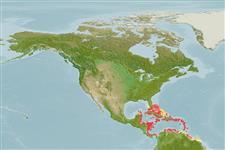>
Eupercaria/misc (Various families in series Eupercaria) >
Scaridae (Parrotfishes) > Sparisomatinae
Etymology: Sparisoma: Latin, sparus = a fish with a golden head + Greek, soma = body (Ref. 45335).
More on authors: Bloch & Schneider.
Environment: milieu / climate zone / depth range / distribution range
Écologie
marin récifal; profondeur 1 - 15 m (Ref. 9710). Tropical; 28°N - 4°N, 89°W - 51°W
Western Atlantic: Caribbean Sea.
Taille / Poids / Âge
Maturity: Lm ? range ? - ? cm
Max length : 46.0 cm TL mâle / non sexé; (Ref. 7251); common length : 25.0 cm TL mâle / non sexé; (Ref. 3802)
Épines dorsales (Total): 9; Rayons mous dorsaux (Total): 10; Épines anales 3; Rayons mous anaux: 9. Young adults with black saddle-shaped markings at upper end of pectoral fin base; often vague, pale saddle-shaped area on top of caudal peduncle; and dorsal, anal, and pelvic fins red or orange (Ref. 26938).
Occurs in coral reefs and adjacent habitats, the young especially in seagrass beds. Juveniles or primary-phase adults rapidly assume a mottled pattern with which they blend with the substratum when they come to rest on the bottom. Feeds on benthic algae and seagrasses.
Life cycle and mating behavior
Maturité | Reproduction | Frai | Œufs | Fécondité | Larves
Although protogyny was propossed for this species (Ref. 27876), probably because testicular characteristics showed a secondary characteristic of sex-changed males, observations of overlapping size ranges of males and females, and males maturing at the same ages and sizes as did females, strongly suggest gonochorism (Ref. 103751).
Robins, C.R. and G.C. Ray, 1986. A field guide to Atlantic coast fishes of North America. Houghton Mifflin Company, Boston, U.S.A. 354 p. (Ref. 7251)
Statut dans la liste rouge de l'IUCN (Ref. 130435)
Menace pour l'homme
Reports of ciguatera poisoning (Ref. 30303)
Utilisations par l'homme
Pêcheries: intérêt commercial mineur; Aquarium: Commercial
Plus d'informations
RéférencesAquacultureProfil d'aquacultureSouchesGénétiqueElectrophoresesHéritabilitéPathologiesTraitementNutrientsMass conversion
Outils
Articles particuliers
Télécharger en XML
Sources Internet
Estimates based on models
Preferred temperature (Ref.
123201): 26.5 - 28.3, mean 27.6 °C (based on 471 cells).
Phylogenetic diversity index (Ref.
82804): PD
50 = 0.5000 [Uniqueness, from 0.5 = low to 2.0 = high].
Bayesian length-weight: a=0.01072 (0.00697 - 0.01647), b=3.10 (2.97 - 3.23), in cm total length, based on LWR estimates for this species & Genus-body shape (Ref.
93245).
Niveau trophique (Ref.
69278): 2.0 ±0.0 se; based on diet studies.
Generation time: 1.8 ( na - na) years. Estimated as median ln(3)/K based on 2
growth studies.
Résilience (Ref.
120179): Haut, temps minimum de doublement de population inférieur à 15 mois (K=0.7).
Fishing Vulnerability (Ref.
59153): Low vulnerability (23 of 100).
Nutrients (Ref.
124155): Calcium = 54.9 [32.2, 104.2] mg/100g; Iron = 0.781 [0.413, 1.321] mg/100g; Protein = 18.5 [16.3, 20.9] %; Omega3 = 0.0942 [, ] g/100g; Selenium = 33.3 [18.8, 63.7] μg/100g; VitaminA = 34.7 [10.3, 119.0] μg/100g; Zinc = 1.64 [1.12, 2.59] mg/100g (wet weight);
